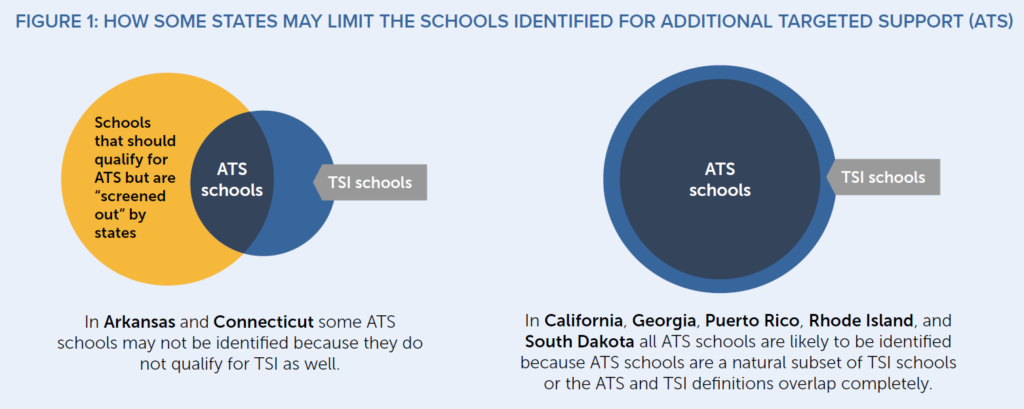Screened Out? How Some States May Limit the Schools, and Students, Identified for Support
Under the Every Student Succeeds Act (ESSA), states have reimagined their school accountability systems and come up with new ways to identify schools for support and improvement. Although the federal law allows some flexibility in designing these methodologies, it requires states to identify schools for three categories of support: comprehensive, additional targeted, and targeted support and improvement (CSI, ATS, or TSI, respectively).
ESSA is the most prescriptive regarding CSI and ATS schools. States must identify schools for CSI when the whole school is among the bottom 5 percent of Title I schools in the state. Meanwhile, they must identify for ATS those schools in which a subgroup of students, on its own, performs as poorly as schools identified for CSI. While states can select some of the measures of student success they use—and determine how to weight different indicators such as academic achievement, academic growth, and high school graduation rate in their systems—they must identify schools that fall below the thresholds set in the law. For TSI, however, states have much more flexibility: they must identify any school with a “consistently underperforming” subgroup of students, as however that is defined by the state. As states’ ESSA plans reveal, these definitions vary widely.
Even though both categories focus on schools with low-performing subgroups of students, whether a school is identified for ATS or TSI has special significance. Under ESSA, only ATS schools—not TSI schools—that are Title I schools and fail to improve can become CSI schools, triggering additional state oversight.
In carrying out these requirements, most states created definitions of ATS and TSI schools they apply to all their public schools. Under ESSA, however, states can choose to select ATS schools exclusively from those already identified for TSI.
There are many plausible reasons a state might choose to do this, an obvious one being that states want to reserve ATS status for schools that truly need additional support because they have subgroups of students who are lower performing or have been struggling for a longer period than those in schools identified for TSI. Whatever the intentions behind the policy, however, there is a potential problem—schools with low-performing subgroups that meet ESSA’s definition for ATS will not be identified unless they also meet the state’s definition of TSI. Thus, if the state’s definition for TSI is narrower than ESSA’s definition of ATS, states will miss schools that otherwise would be identified if the definition of ATS was applied to all schools. (See the graphic below.)

To understand whether schools with low-performing student subgroups are being “screened out,” and not identified for ATS when they otherwise would be, the Alliance for Excellent Education (All4Ed) examined the policies of the nine states and Puerto Rico that use this approach in their ESSA plans. Based on All4Ed’s analysis of the states’ TSI and ATS definitions, the good news is that half of the states—California, Georgia, Rhode Island, and South Dakota—and Puerto Rico are unlikely to limit the number of schools identified for ATS because those schools are a natural subset of TSI schools. Every school meeting the ATS threshold set in ESSA will, by design, also meet the TSI threshold set by the state.
But two states—Arkansas and Connecticut—are likely to underidentify schools for ATS because their definitions for “consistently underperforming” are narrower than ESSA’s definition for ATS schools. In other words, TSI schools are likely to be a subset of ATS schools, when the reverse should be true. The effect of the screening process is unclear in the remaining states: Michigan, Virginia, and Wisconsin.
A central value underlying ESSA is that every student should have the opportunity to succeed. A key way the law advances that goal is requiring improvement efforts in schools when even one subgroup of students is struggling, even if the overall student population does not. While the law gives states flexibility in selecting schools for TSI, resulting in states adopting a wide variety of approaches, ESSA intentionally was much more prescriptive in its definition for ATS schools by establishing a floor below which schools must receive support. When states screen out schools—and, therefore, students—that otherwise meet ESSA’s ATS definition, states undercut this federal guarantee of action.
Fortunately, only a small number of states currently use this approach in a problematic way, combining screening with a TSI definition that is narrower than ESSA’s ATS definition. Those states should rethink their policies related to the screening process, their TSI definitions, or both to ensure that more students receive the support they need and deserve. As other states rethink their systems and amend their ESSA plans over time, states should “screen” with caution. States that choose to use this approach should do so in a way that reinforces the intent of the law for each state to identify, at a minimum, those schools with the very lowest-performing student subgroups.
Lindsay Dworkin is director of policy development and state government relations and Anne Hyslop is assistant director of policy development and government relations at All4Ed.
Featured image by Allison Shelley/The Verbatim Agency for American Education: Images of Teachers and Students in Action
